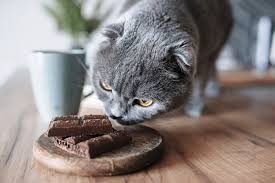Introduction
As cat owners, we want to ensure our feline friends are safe, happy, and healthy. While cats are often seen nibbling on anything that catches their attention, not all foods that humans enjoy are safe for cats. Chocolate, in particular, is one treat that’s extremely dangerous for our pets. In this article, we’ll explore the risks of chocolate consumption for cats, what makes it toxic, the symptoms to watch out for if your cat ingests chocolate, and safe alternative treats that cats can enjoy without harm.
Why Chocolate Is Toxic for Cats
Chocolate contains two compounds that are harmful to cats: theobromine and caffeine. While these substances are relatively harmless to humans (unless consumed in large amounts), they can cause serious health problems for cats and other animals. This is because cats metabolize theobromine and caffeine much more slowly than humans, leading to potentially toxic levels in their system.
The amount of theobromine in chocolate varies by type:
- Dark chocolate has the highest concentration of theobromine, making it the most dangerous.
- Milk chocolate has lower theobromine levels but can still be toxic.
- White chocolate contains minimal theobromine but still has enough to cause mild symptoms in cats if consumed in large amounts.
Even small amounts of chocolate can be harmful to cats, so it’s best to keep all types of chocolate away from them.
Health Risks of Chocolate Consumption in Cats
Theobromine Poisoning
The primary risk of chocolate consumption in cats is theobromine poisoning. Theobromine affects the central nervous system, heart, and kidneys, causing symptoms such as rapid heartbeat, tremors, and muscle rigidity. Since cats are much smaller than humans, they are more susceptible to even small amounts of theobromine.
Caffeine Toxicity
Alongside theobromine, chocolate also contains caffeine, another stimulant that can harm cats. Caffeine toxicity in cats can lead to restlessness, increased heart rate, and even seizures in severe cases. This is because caffeine speeds up the metabolism and overstimulates the nervous system.
Potential Fatality
In severe cases, chocolate poisoning can be fatal for cats. If a cat ingests a large amount of chocolate, particularly dark or baking chocolate, the high levels of theobromine and caffeine can overwhelm their system, leading to fatal complications such as cardiac arrhythmia or respiratory failure. Immediate veterinary care is essential if chocolate ingestion is suspected.
Symptoms of Chocolate Poisoning in Cats
It’s important to recognize the symptoms of chocolate poisoning in cats so you can act quickly if needed. Symptoms usually appear within 6 to 12 hours after ingestion and can last for up to 72 hours, depending on the amount of chocolate consumed.
Common Symptoms of Chocolate Poisoning in Cats:
- Vomiting and diarrhea: One of the earliest signs, as the cat’s body tries to rid itself of the toxin.
- Increased thirst and urination: Caused by caffeine’s diuretic effect.
- Restlessness and hyperactivity: Stimulants in chocolate affect the nervous system, making cats overly active or anxious.
- Rapid breathing and increased heart rate: Signs that the central nervous system is overstimulated.
- Tremors or muscle rigidity: As toxicity progresses, cats may experience involuntary muscle movements.
- Seizures: In severe cases, chocolate poisoning can lead to seizures or convulsions.
- Coma or death: If left untreated, chocolate poisoning can result in life-threatening complications.
If you suspect your cat has consumed chocolate and shows any of these symptoms, contact your veterinarian immediately.
What to Do if Your Cat Eats Chocolate
Immediate Steps
If you believe your cat has ingested chocolate, quick action is essential. Here are the steps to follow:
- Assess the Situation: Try to determine how much chocolate your cat may have consumed and the type of chocolate (dark, milk, or white).
- Call Your Veterinarian: Describe your cat’s symptoms and the amount of chocolate they may have eaten. The veterinarian will advise you on the next steps, which could include bringing the cat to the clinic for treatment.
- Do Not Induce Vomiting Without Veterinary Advice: Unlike with dogs, inducing vomiting in cats at home is risky and should only be done under a veterinarian’s guidance.
Veterinary Treatment
When you take your cat to the vet, they may perform several procedures to remove the toxin from their system and stabilize their health. Common treatments include:
- Activated Charcoal: Given to help absorb the toxins and prevent further absorption of theobromine and caffeine.
- IV Fluids: Used to keep the cat hydrated and help flush the toxins out of their system.
- Medications: The vet may administer medications to control symptoms such as tremors or seizures.
- Monitoring: Severe cases may require intensive monitoring of heart rate, respiratory function, and neurological symptoms.
The sooner treatment is initiated, the better the chances of recovery, as prompt intervention reduces the risk of permanent damage or fatality.
Safe Alternatives to Chocolate for Cats
While chocolate is off-limits, there are many safe and enjoyable treats for cats. Here are some alternatives that provide a tasty reward without any of the risks associated with chocolate.
Catnip Treats
Most cats love catnip, and catnip-based treats offer a safe and satisfying way to indulge your pet. Catnip stimulates a playful, euphoric response in cats without any harmful effects, making it a great option.
Cat-Specific Treats
There are a wide variety of treats formulated specifically for cats that cater to their taste preferences and dietary needs. Look for treats made from high-quality proteins, such as chicken, salmon, or tuna, which are healthier options for your feline friend.
Small Portions of Fresh Meat or Fish
Cats are carnivores by nature, and small pieces of cooked chicken, turkey, or fish can be a safe and delicious treat. Be sure to cook the meat thoroughly, and avoid adding any seasonings, as some ingredients, like garlic and onion, are toxic to cats.
Pumpkin Puree
Plain, canned pumpkin puree (not pie filling) is another safe treat for cats. Pumpkin is rich in fiber and beneficial for digestion, and most cats enjoy its mild taste.
Freeze-Dried Meat Treats
Freeze-dried meat treats, made from single ingredients like chicken or salmon, are a healthy, low-calorie snack option. These treats are free from additives and preservatives, making them ideal for cats with sensitive stomachs.
How to Prevent Chocolate Ingestion in Cats
The best way to prevent chocolate poisoning in cats is to take proactive steps to limit their access to chocolate and other harmful foods.
Keep Chocolate Out of Reach
Store all chocolate products in cabinets or pantries that are inaccessible to cats. Cats are curious creatures and may jump onto counters or shelves, so it’s essential to keep chocolate securely stored.
Be Cautious During Holidays
Holidays like Christmas, Easter, and Halloween often involve an abundance of chocolate in the home. Keep a close eye on your cat during these times, and make sure all treats are out of their reach.
Educate Family Members and Guests
Ensure that everyone in the household understands the risks of chocolate for cats. It’s common for well-meaning family members or guests to offer pets food without realizing it could be harmful.
Avoid Sharing Human Treats
It can be tempting to share food with your cat, especially when they show interest. However, sticking to treats that are formulated for cats is the safest option, as many human foods contain ingredients that are toxic to cats.
Conclusion
While it’s natural to want to share treats with our beloved pets, it’s essential to remember that chocolate is highly toxic to cats. The risks of chocolate consumption in cats include theobromine and caffeine poisoning, which can lead to symptoms ranging from vomiting and diarrhea to seizures and even death in severe cases. By understanding the dangers of chocolate and choosing safe, cat-friendly treats instead, you can help keep your cat healthy and happy.
Whenever in doubt, consult your veterinarian before introducing new foods to your cat’s diet. A bit of caution and a focus on safe treats can go a long way in ensuring your cat’s well-being and longevity. Keep your chocolate to yourself and offer your cat one of the many delicious and safe alternatives available instead





